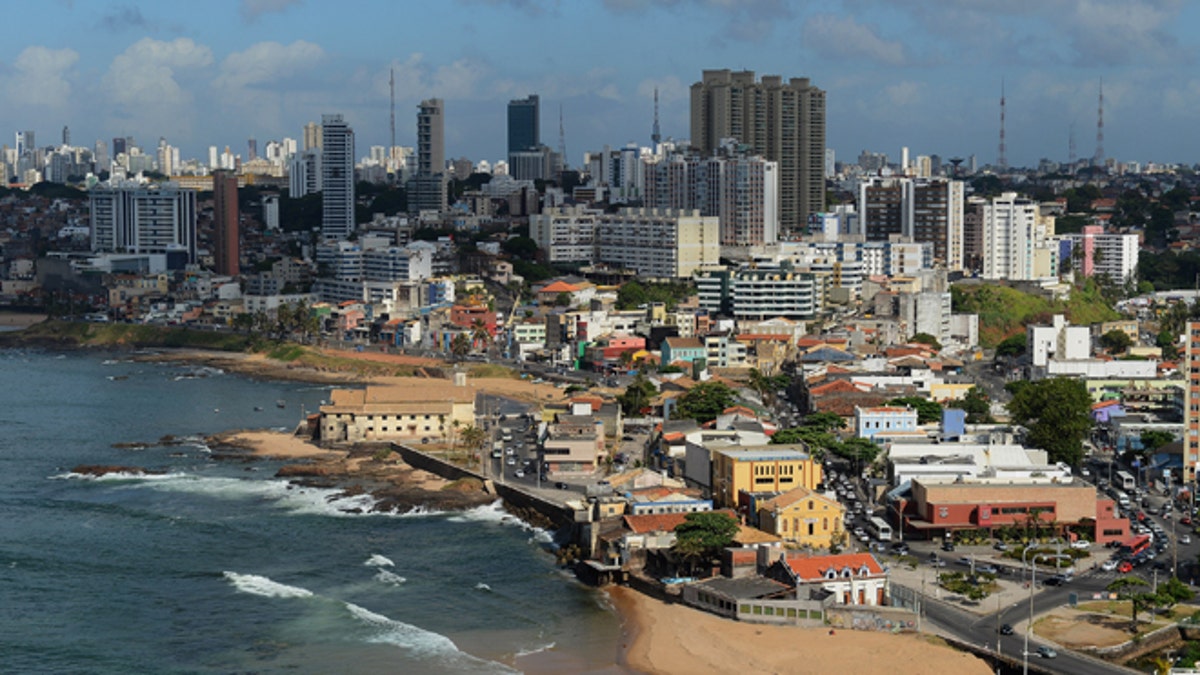
SALVADOR, BRAZIL - DECEMBER 07: A view of the city on December 7, 2012 in Salvador, Brazil. (Photo by Shaun Botterill/Getty Images) (2012 Getty Images)
The 2014 World Cup is right around the corner, and thousands of tourists will soon flock to Brazil for the games, as well as all the culture, beauty and excitement that the host country has to offer. To give travelers – and anyone interested in Brazil – a sense of the possibilities, Fox News Latino has compiled a concise list of things to do, places to stay, what to eat and more for each of the 12 cities that will host World Cup matches.
Salvador (Bahia)
The Town: The oldest Portuguese urban settlement in Brazil, Salvador – which is sometimes referred to by the name of the state it's in, Bahia – has been a hub for the mixing of cultures almost since its founding. Its nefarious past as a port central to the slave trade, and its strong connection with Brazil’s indigenous population has turned the northeastern city into one of the most culturally diverse and entertaining in the country. From the circles of the dance-fighting art of capoeira to the pulsating rhythms of the agogôs and atabaques percussion instruments, one of the most physically beautiful cities in all Brazil has a feeling all its own. It is also the birthplace of some of Brazil’s most famous artists.
The Stadium: The brand new 52,048-capacity Arena Fonte Nova rose out of the ashes of Estadio Octavio Mangabeira. The stunning new structure overlooks a lake and features a lightweight metal roof along with a separate complex housing a panoramic restaurant, a soccer museum, car parks, shops, hotels and a concert hall. The stadium will also see its fair share of World Cup action, hosting six games including the highly anticipated 2010 final rematch between reigning champion Spain and the Netherlands on June 13.
Weather: While temperatures can get to the high 90s even during the winter, Salvador is blessed with a cooling sea breeze. Along with the wind, however, come frequent July rain storms off the Atlantic, so bring a rain jacket or be prepared to get wet.
- Brazil’s President Rousseff Defends Journalist Who Received Rape Threats
- Brazil Racing To Have Infrastructure Ready In Time For Soccer World Cup
- Brazil Surfer Dogs Take To The Waves On Paddle Boards
- Brazilian Cops Cover Graffiti Artist’s Face In Black Paint As Punishment
- Brazilians Angry Over Waste And Poor Planning Before World Cup
- Best Pix From Latin America
- Brazilian Surfer Bruna Schmitz Is More Than Just A Pretty Face
What To See: Salvador is separated into the Cidade Baixa and Alta (Low and High City) with plenty to explore in both, but the connection between is certainly worth a trip. The Art Deco Elevador Lacerda connects the two areas via four elevators that travel 235 feet in about 30 seconds. The elevators began as as manual rope-and-pulleys installed by Jesuit priests around 1610. Once in the Cidade Alta, the Pelourinho is the place to go. Salvador’s historic center is a UNESCO World Heritage site, and tourists can wander the cobblestone streets and gaze at the city’s oldest architecture. Salvador is a town built by sea explorers and down in the Lower City, the Museu Náutico da Bahia gives visitors a glimpse of relics from the golden era of Portuguese seafaring as well as exhibits on the slave trade.
Where To Stay: There are a multitude of great places to stay in Salvador but the cream of the crop is the Pestana Convento do Carmo. Set in a 17th century convent, this hotel features a luxurious mix of Old World charm and modern comfort. The Deville Salvador, housed inside a scenic park filled with lakes and exotic birds, is another stunning option. The Deville has two bars, two restaurants, a health club, a tennis court, a gym and a volleyball court to go along with their cushy digs. If these two places are out of your price range then the Hotel Villa Santo Antonio may be up your alley. An upscale guesthouse that features the polished wood floors, stunning views and original artwork, this hotel is one of a kind.
Where To Eat: The diverse culture in Salvador has given the city a culinary style all its own. For the best local food in town try Restaurante do SENAC, where the moqueca (a spicy stew of coconut milk, pepper and seafood or meat) is praised citywide. For a quaint dining experience with a stunning view of the ocean, Cafélier serves up cappuccinos, chocolate cake, wines and caipirinhas to a loyal crowd. Caranguejo de Sergipe is a local hotspot for grilled fish and vegetables.
Where To Drink: Get ready to party because the home of tropicalia and baile funk do their nightlife right. The ever popular Sankofa African Bar features live samba, semba, salsa and DJs spinning international beats, with a mix of tourists and locals crowding into this Pelourinho joint. Samba, samba de roda, jazz and MPB (Música Popular Brasileira) are all on display at D’Venetta in the San Antonio neighborhood, and for a night of some of the best live music in Brazil, Commons Studio Bar is relatively new place with a rustic feel that draws acts from all over the country.
Day Trip: About 50 miles north of Salavdor is Praia do Forte where visitors can enjoy the beach but also visit its famed turtle preserve. The Projecto Tamar is one of the most successful preserves in the country and its main objective is to protect sea turtles from extinction on the Brazilian coastline. After seeing the turtles, get a firsthand look at more ocean-based wildlife by snorkeling in the ocean and tide pools that are filled with fish and other sea creatures.
Follow us on twitter.com/foxnewslatino
Like us at facebook.com/foxnewslatino
